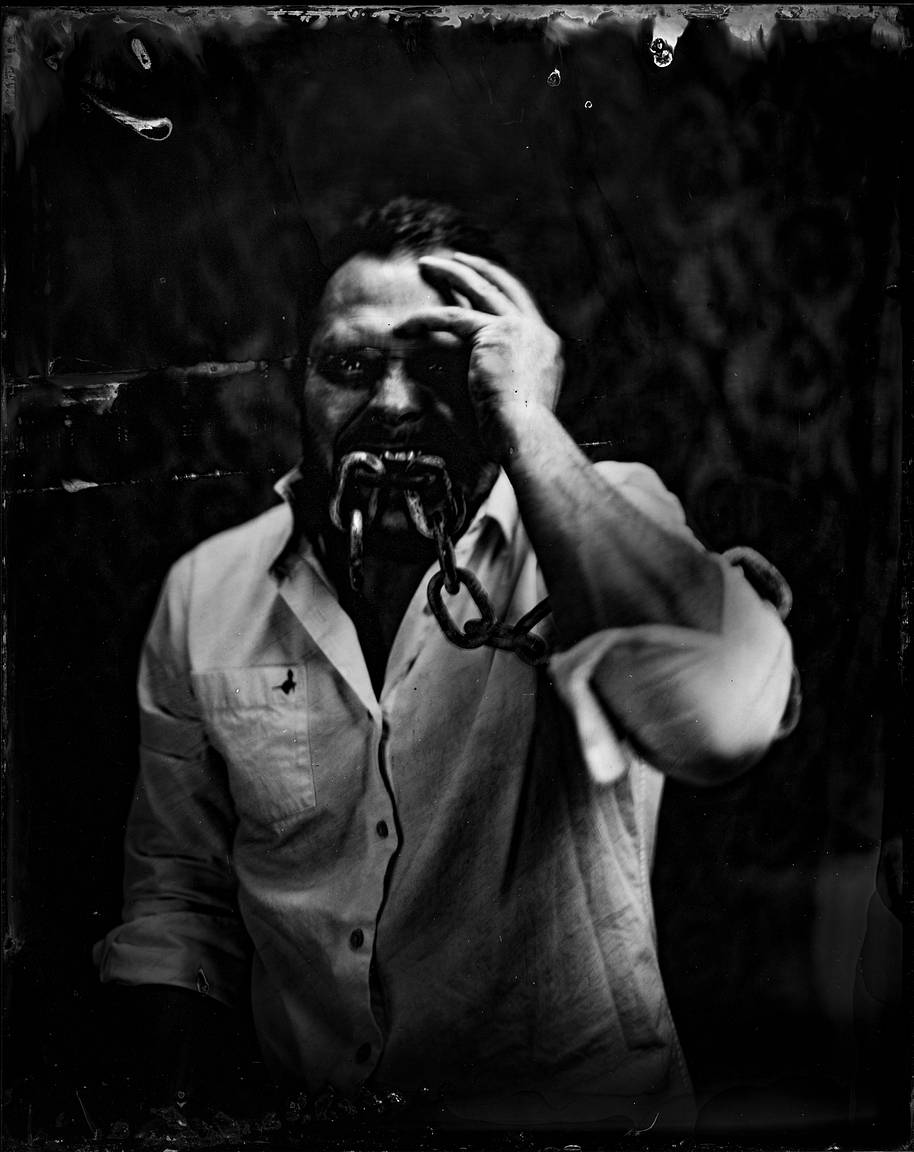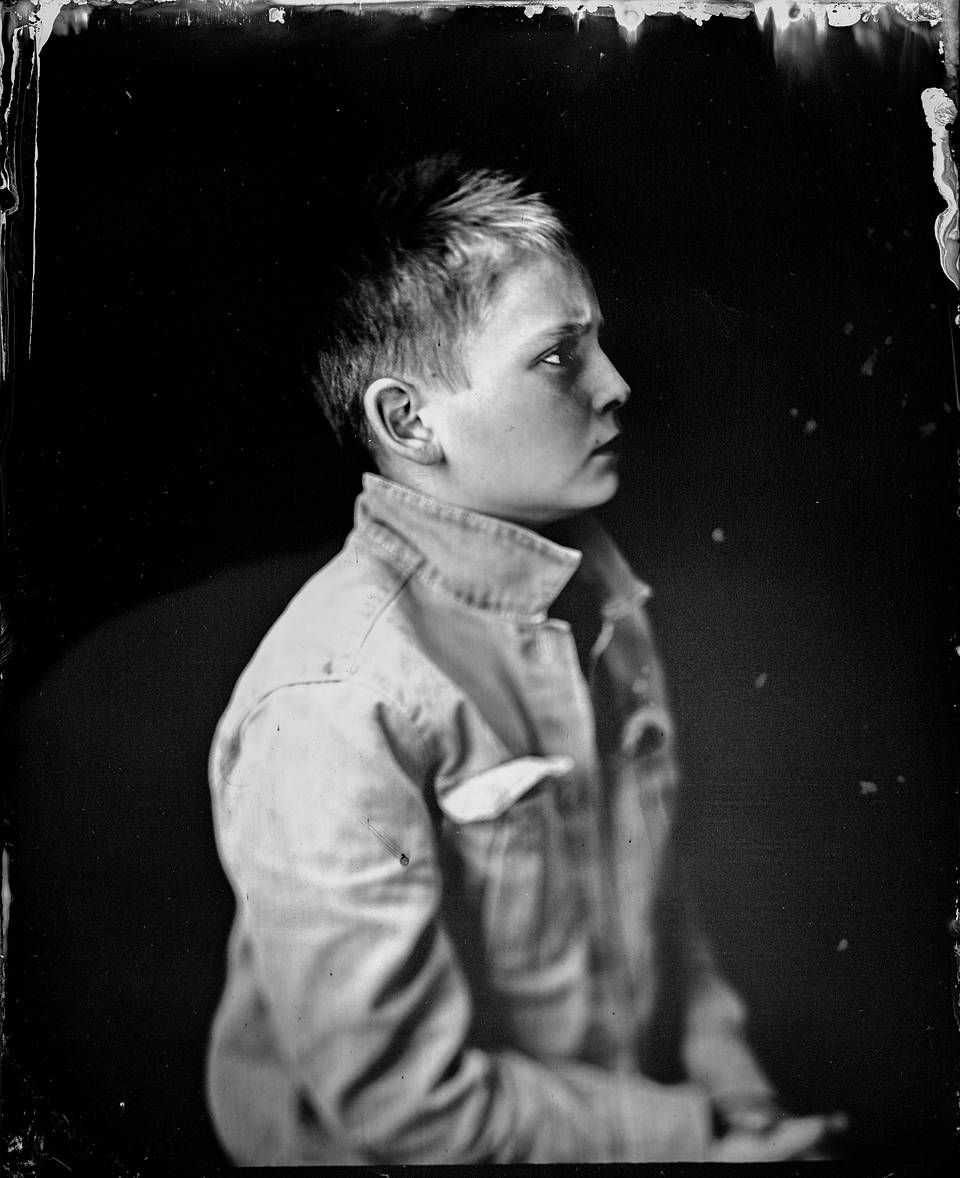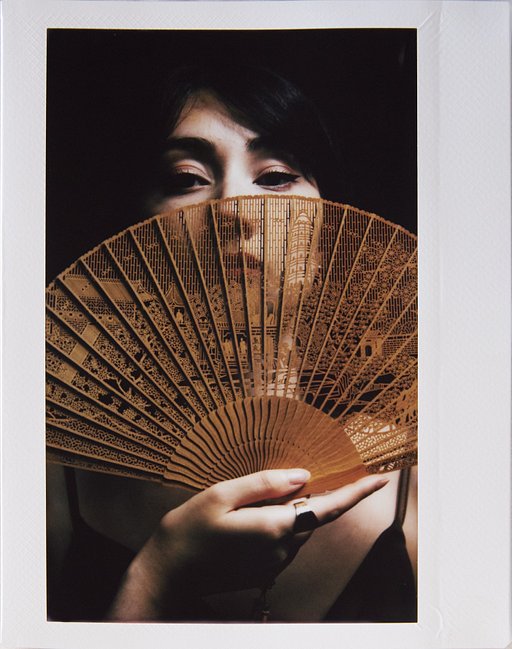Inside the MentalCollodion Darkroom: An Interview with Simon Riddell
11 Share TweetProfessional darkroom photographer Simon Riddell is a man on a mission as he explores topics of mental health and human cognition through Victorian wet plate photography. To do this, he is now aiming to build a darkroom mobile via GoFundMe to allow himself to travel and shoot more high-quality plates of enigmatic portraiture. Learn more about the artist through this interview.
Hey Simon! Firstly. How are things with you so far?
Primarily I’m busy with the MentalCollodion Project, which I’m feeling really positive about and it’s taking up a lot of time and energy at the moment. I’ve also been working on filming a docu-series at Inchindown, (the underground WWII once top-secret oil storage facility), it’s a separate project to my previous documentary shot with David Allen at the facility, called One Shot: Inchindown.
Throughout COVID-19 I kept working which has been a bit daunting and has impacted my mental health a fair bit. I’m diabetic and have a susceptible immune system, so I’ve had to navigate the various risks and keep the money coming in, it’s not been easy. Lockdown was really difficult for me personally and I lost a long-term relationship, which knocked me for six.
Other than that, it’s just been full-on in the darkroom with collodion.
When did you start getting interested in more historical photographic and printing processes?
It’s been a transitional process for me. I started shooting film about four and a half years ago on my dad’s Canon AE1 SLR, and things just snowballed from there. I started to get seriously into wet plate about six months ago and haven’t really done much since.
For me, the more challenging the photography, the more I become immersed in it, and I very quickly graduated from 35mm to Medium Format and then to Large Format. From there I moved onto 8”x10” paper negs, mainly because of the cost of film at that size. Around a year ago I was helping a best mate and photographer Keith Moss to convert a van into a mobile darkroom and he sparked my interest in wet plate.
We shot an ambrotype (glass negative) of my son, Isaac, in a forest. The exposure was around 16 seconds with the lens stopped down on an overcast day, and the resulting image just blew me away. I immediately started down the collodion rabbit hole, researching the process, converting my large format camera, and investing in the chemicals, which is itself a major commitment. It’s a crazy learning curve and I made a lot of mistakes (still do) but for me, that’s a major part of the attraction, the harder the better. Once you nail it you can start to bring your creativity into play.
For people who don’t know about my One-Shot: Inchindown project, it was one of the hardest things I have ever done in photography. Working with large format film in total darkness in a vast underground oil tank, we produced a 127cm fiber print. It was a uniquely challenging environment using technology that is dependent on light, but I was drawn to it specifically because of these challenges. It adds to a sense of achievement and I don’t connect with the subject in quite the same way when using digital. Digital isn’t where it’s at with me, and I enjoy the other creative aspects demanded of the process, such as building cameras and finding ways to use antique lenses. I like how with a wet plate you really have no choice but to embrace the experimental side of things.
Wet plate requires patience and is wildly inconvenient when compared to digital and other analogue formats, I was actually afraid that shooting film wouldn’t be enough for me after collodion. You can’t easily meter for the light and have to rely on experience and instinct in a way that appeals to me. It is also unrivaled in terms of quality and resolution. I’m very committed to shooting the old-school ways in the modern world.
We are extremely intrigued by the plates you made, particularly the expressions of your self-portraits. Share to us - what sparked and propelled the MentalCollodion project?
This is the big question – there’s a lot of stuff in there. There’s obviously the personal journey, past experiences, living with PTSD, and the desire to capture 10 second’s worth of my life and the states of mind that I’ve been in, and had to deal with.
With my plate ‘Many Minds’ I was trying to visualize being in a fragile state of mind. It’s probably one of my best plates and linking it back to my experiences of PTSD has helped me to better understand and manage those aspects of an uncentred mindset, flashbacks, paranoia, and hypersensitivity. Doing this kind of immersive photography and being creative with how I am feeling in those moments is a kind of coping mechanism. There’s a lot of planning that goes into making a wet plate, all of which helps keep you focused on that creative experience. Before you know it, you’ve been working for 3-4 hours and shot one plate, and it’s always exciting to see whether you’ve nailed it when the image starts to breathe life.
In the image my eyes are clear and the face you see is focused, centered, appearing to be in control, but the plate also highlights the underlying duality – you never know what’s going on with somebody below the surface. The plate tries to capture those periods of excruciating self-awareness, spiraling feelings of self-doubt, negative self-talk, inwardly questioning whether other people are judging you, but at the same time trying to reel it back in and become the focused person image looking straight down the camera. I wanted the plate to move into that realm of being, a person who’s trying to be mindful of the present but also fighting the urge to fixate on the past and plan or worry about the future. This is something that I personally have to work at because my thought process can spiral very quickly, and I feel this kind of personal exploration comes across well in wet plate.
This image uses both multiple and long exposures, techniques that are integral to my work allowing me to develop a range of visual narratives on a single plate. Technically speaking it’s not a perfect plate but I like those imperfections, and there’s definitely something about those characteristics that work in this context and this is something I want to communicate through the MentalCollodion Project.
As the originators of the technique who traveled from job to job with a covered wagon, the MentalCollodion Project will take the wet plate process on the road, hopefully throughout the world. The intention is to photograph people and soak up whatever they are going through at that moment and put it on a plate. It is an intimate and emotional experience, in fact, if you don’t make a connection with a person, the plates don’t really work. Once photographed, the sitter will be able to keep this unique plate, taking what can be distressing and troubling experiences of mental health and creating something positive. I will be able to scan the plates to share with a wider audience, but the moment of creating the plate must be a one-off. Establishing a digital presence will be key in ensuring that these stories can be shared, and I am keen that these plates should promote wider conversations about mental health and wellbeing, which is especially important now, during COVID.
I’ve never pulled any punches with my photography – even if I’m doing bread and butter work like a wedding. I don’t like to pose people, yes you can arrange people to a certain extent, but with MentalCollodion I won’t be saying “smile for the camera”. Shane Balkowitsch (someone who has been incredibly supportive of me) was recently interviewed by Sunny16podcast and discussed a similar topic. The long exposures give you something really special – 10 seconds is a long time - I’ve only had one person come into the studio and nearly nail a smile. With MentalCollodion the project is going to go into some dark places for people, and few people are truly comfortable sitting in front of a camera at the best of times, so I need to be able to capture what somebody is feeling in that moment. It needs to be 100% genuine. And that’s where the emotional side comes into it, it’s difficult to go through that process with somebody. You have to build a relationship and establish trust.
MentalCollodion has to be able to get into the nitty-gritty, harsh, and vulnerable side of the psyche and transfer that energy onto a plate. That, in a nutshell, is what I’m going to do. Lockdown, for me, meant getting into my head and transposing that mental landscape and what I was feeling and suffering on a bed of collodion and silver nitrate. It’s been cathartic.
You’ve mentioned that you want to be able to link back the social aspect of this art, especially in the time of the COVID-19 pandemic. Can you tell us more as to how the MentalCollodion project will actually function? If you could walk us through the process, please do!
Pending funding, I’ll convert a van into a mobile darkroom and equipment cache which is something I’ve done before, but not for collodion. That’s step one, which allows me to travel legitimately to do my job, subject to Government COVID-19 restrictions.
I’m looking to shoot 50 plates in the first year, roughly 1-2 a week. People will be able to contact me, find out more, book a sitting, and thereafter scan, share and publicize their stories and experiences with wet-plate collodion. There will be a strong online presence, MentalCollodion is on Instagram and Facebook @mentalcollodion. I see these platforms as offering a safe place for people to share their experiences and find some support, however small it may be, that support might just make all the difference. Let’s not dull it down, people are committing suicide due to their situations, circumstances, and states of mind. This cannot go on.
It’s important to stress that I’m not offering mental health advice or counseling, instead, we’re talking, we’re building a relationship and capturing 10 seconds of your life on a plate, which you will keep and hopefully pass on to loved ones.
The project is already underway and has proven to have made a difference to the people already. This includes three soldiers (two retired, one currently serving), and it's been awesome to get their feedback and share their experiences. When they look at the plate it’s something that they feel good about. It’s exciting to be able to provide people with this kind of positive mental health experience while also raising awareness for mental health and wellbeing. It’s something I feel passionately about. It’s also my intention to run workshops to bring the Victorian process to interested people, so that they can learn and perhaps will be inspired to shoot themselves and maybe help people along the way, too.
The ghostly, horror-esque aesthetic seems very defined in the series. What do you particularly look for in the portraits that will come out of this project?
The ghostly and spectral aspects of my work lend themselves well to explorations of the psyche and these otherwise ambiguous parts of our inner lives. I believe that using different techniques to add layers of intrigue to an image is a great way to think about those parts of ourselves that are difficult to comprehend. Overall, I’m looking is vulnerability and sincerity - a sincere, genuine, real glimpse of someone’s life, and to collaborate with that person is sharing what they’re going through. To reiterate, I’ve never pulled punches, and this project won't, either, it’s going to hit hard.
The plates are archival in quality, meaning they will be around long after I pop my clogs, which means that people holding these plates in 200 years will be able to experience and connect with both my sister and myself and our experiences together. When these fifty, or so plates are exhibited it will be an accurate reflection of the time stamp that COVID-19 has permanently marked us with. I want this work to support people creatively and give others access to a positive experience in wet-plate collodion, especially during this difficult period.
People sometimes say that a picture should speak for itself, but I want to go further than this (this is where my collaborator Paul Whitehouse comes in). I am committed to fully documenting this process and aim to combine the plates with an additional and enhanced narrative. For instance, I will allow sitters to not only document their feelings as a kind of visual metaphor but also in the written and recorded word. It is important to the social and communal value of the project to record these experiences in a variety of ways, including some critical readings of the plates, and different ways of personalizing them. For example, sitters will be able to inscribe the back of their plate, and, if appropriate, I will record a video of our time together to form the basis of a documentary film, centered on promoting positivity and self-care, and compassion for one another.
For you, what phase of your creative process is the most fulfilling and enjoyable?
The experience of meeting somebody, forming a bond, and bringing that spirit out in collodion and silver is paramount. The process side of things fascinates and challenges me creatively, but without forming that relationship with someone, you won’t capture their spirit or what they truly feel, there is a lot to be said for true photographers being compared to shadow catchers. I’m also drawn to the intuitive nature of wet plate photography. For instance, when you look at a plate, when it’s coming to life in the trays, you’re trying to feel your way through the process, letting it go for a few seconds longer to come to life more, or arresting the development before it kills its own visible existence. It’s much the same with exposure times - you have to feel what you’re trying to create from the very start. It’s exhilarating and can also be frustrating, but that is what’s so wonderful about wet-plate collodion. I really do love it all, which is what makes it worthwhile, when you nail it.
Lastly – where do you get all this burst of inspiration?
It’s an interesting one for me because I’m completely self-taught and there’s a lot that I don’t know, and don’t want to know. I’m comfortable with my own self-awareness and like to do my own thing as much as possible. I do, however, draw inspiration from other wet plate photographers and the stories of people I photograph. I’m open to discovering new creativity but in truth, it's more of a personal evolution, where creative projects snowball. I like collaborating with like-minded others and drawing on their inspiration – Shane’s series on Native Americans is a perfect example – the scope of the project is mind-blowing, something like 5,000 plates, which has taken years and countless collaborations to produce, and I find that very inspiring.
For me it’s about recognizing where I am, at the moment, being selective, and looking for opportunities to be around like-minded people, which under COVID can be restricted. This is another reason why MentalCollodion is so necessary – it’s about doing everything you possibly can to remain creative and inspire creativity in other people.
My own mental health journey began with PTSD and through photography and now collodion has brought me to the point where I want to make this experience accessible to others and to help tell their stories so that others can get involved in these vital conversations. It might be an odd sort of inspiration, but I have to credit my inner demons, and there’s a lot in my recent work about having too many minds, and too many thoughts. This is something a lot of people experience and something of which I’ve been able to capture with the MentalCollodion project, already.
I want to put my own spin on mental health topics in the medium of collodion and the initial feedback has been superbly positive. There’s definitely space for this kind of project. A hashtag that I use a lot is #zeronegativey which is something that came into my life a few months ago when I worked with Ant Middleton, Mark 'Billy' Billingham, and Jason Carl Fox I was struck by how my mindset was similar to theirs, particularly Ant’s.
The events that I’ve detailed in this article happened at convergent times when I was just getting seriously into collodion and starting my journey to document mental health and wellbeing. Meeting those guys and seeing how pushing ideas to the max can be its own creative engine has been a powerful tool that is once again reinforced in me.
I’ve taken this to heart. I think the whole process of collodion and long exposures lends itself to self-reflective work, primarily because it’s so immersive and focuses your mind on something positive and creative, and if I can use this process to lift another person, even momentarily, out of whatever challenges that they might be dealing with for a few minutes and capture them on the plate then it will have been worth it. FOR POSITIVITY, AND ZERO NEGATIVITY.
You can support Simon's project through his GoFundMe. You can learn more about his projects through Instagram and Facebook. Visit his website for more details.
written by cielsan on 2020-12-23 #culture #news #people #darkroom #wet-plate-photography #simon-riddell







































No Comments